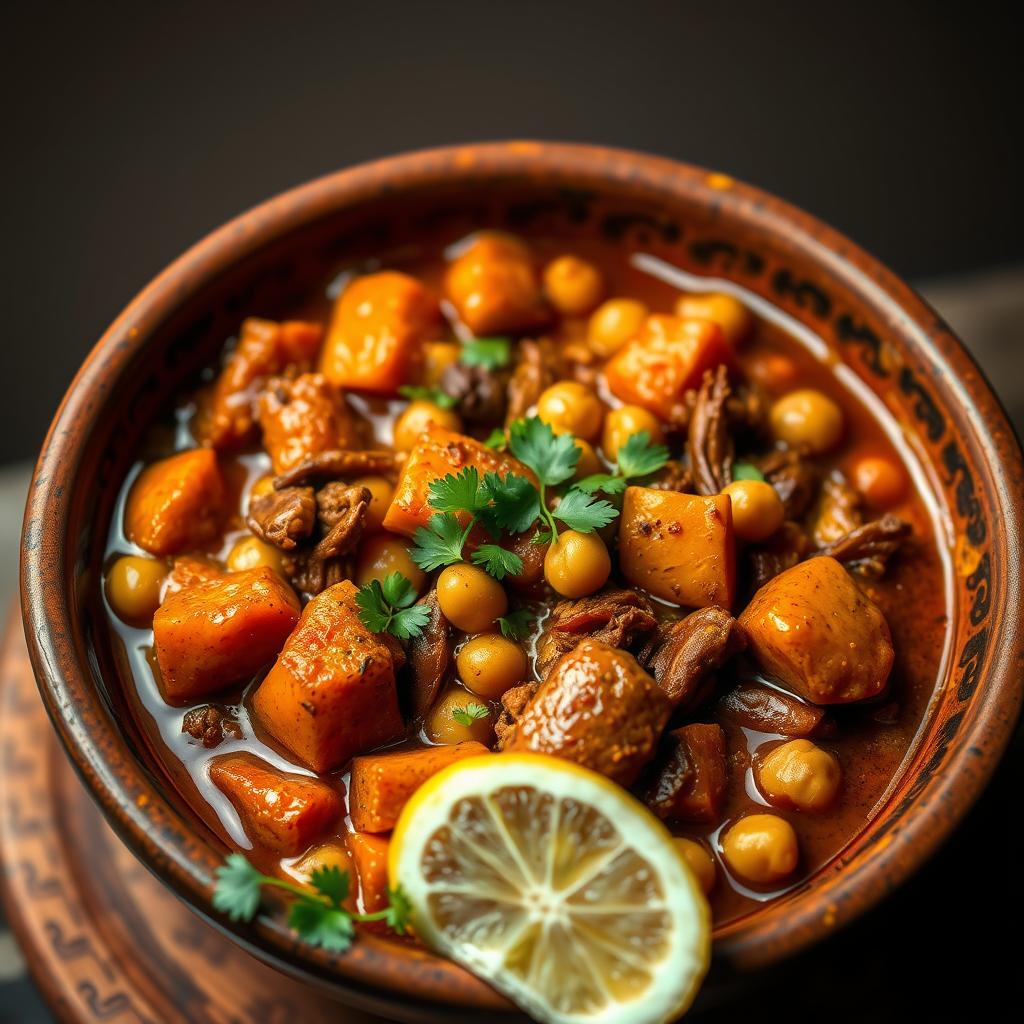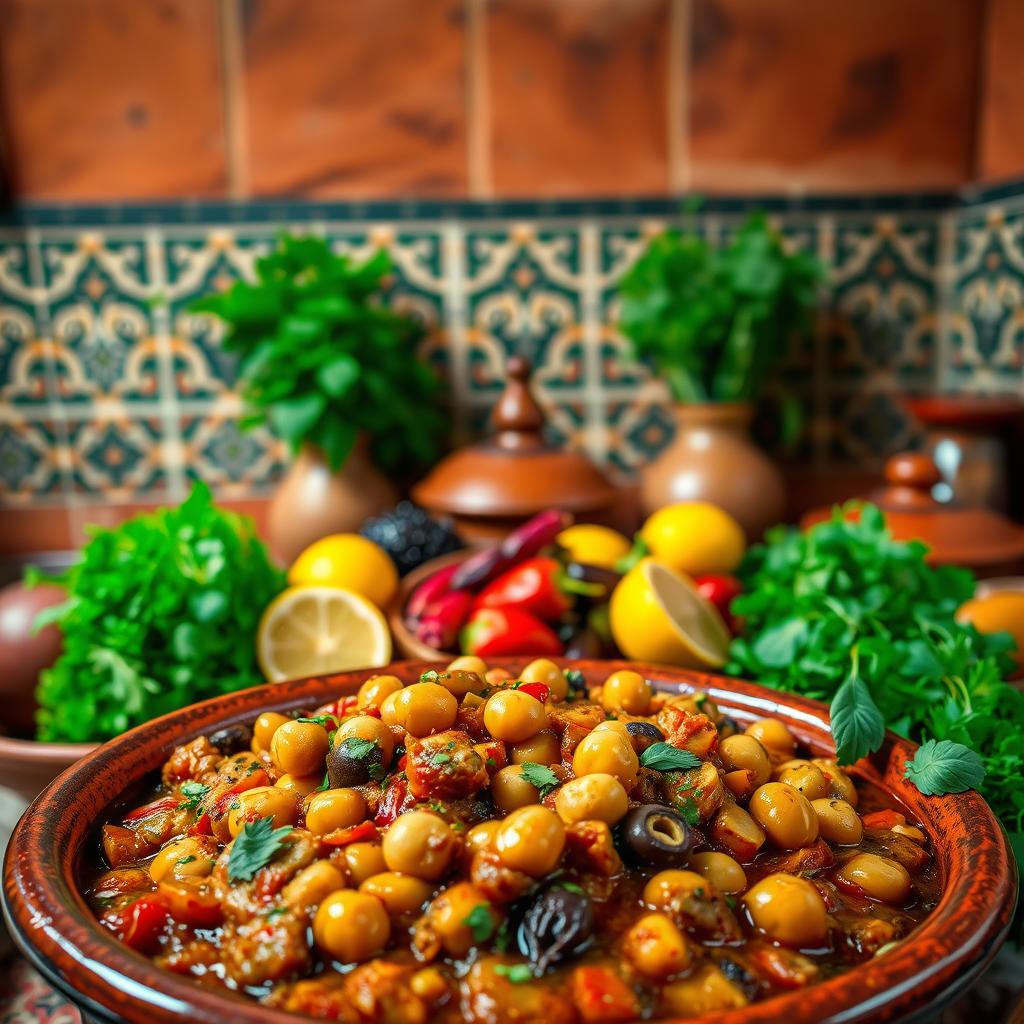Vegan Moroccan recipes open a doorway to bold, north african aromas you can make at home.
Have you ever wondered how a tagine turns simple pantry staples into a deeply spiced, comforting meal that feels both special and easy enough for weeknights?
In this introduction you’ll learn what makes those flavors sing: cumin, cinnamon, turmeric, garlic, preserved lemon, and a drizzle of extra virgin olive oil.
You’ll see how ingredients like chickpeas, tomatoes, and sweet potatoes build texture and depth without animal products.
Practical tips will show you how a tagine, Dutch oven, or any heavy pot can produce the same slow-simmered magic.
By the end of this section you’ll feel ready to craft a balanced meal that pairs slow stews with grains and bright sides for true home-style comfort.
Key Takeaways
- You can recreate authentic north african aromas using pantry staples and spices.
- A tagine or heavy pot is all you need to slow-simmer rich, layered flavors.
- Chickpeas and seasonal vegetables make dishes hearty and satisfying.
- A splash of lemon and good olive oil brightens the whole dish.
- This approach fits weeknight cooking and relaxed entertaining alike.
Vegan Moroccan Recipes
Bring bold North African aromas into your kitchen with simple pantry staples and straightforward technique.
Start here: anchor your cooking around cumin, ginger, turmeric, garlic, and a whisper of ground cinnamon. These aromatic spices form the backbone of a tagine-style stew and give instant depth.
Stock chickpeas, canned tomatoes, lemons, and good olive oil so you can pull together a weeknight meal. When you add onions and warm the oil, bloom the spice to release fragrance before adding vegetables or broth.
- Balance: sweet elements like carrots or sweet potato meet lemon for bright contrast.
- Finish: a drizzle of extra virgin olive oil and a scatter of olives or fresh herbs lifts the stew.
- Checklist: chickpeas, tomatoes, spice blend, lemon, and olive oil keep you ready for any recipe.
| Staple | Why it matters | Use |
|---|---|---|
| Chickpeas | Protein and texture | Add to stews near end to keep shape |
| Tomatoes | Acidity and body | Simmer for sauce depth |
| Olive oil | Flavor carrier | Warm, then bloom spices |
| Ground cinnamon | Warm sweetness | Use sparingly to round flavors |
One-Pot Moroccan Tagine (Vegan, Gluten Free, Weeknight-Friendly)

Turn pantry staples into a fragrant, saucy tagine that cooks mostly hands-off in under an hour.
Ingredients at a glance
Chickpeas, sweet potato, Yukon gold potatoes, onion, garlic, fresh ginger, green olives, lemon juice, thyme, extra virgin olive oil. Use the amounts listed in the brief for a generous 4–6 serving stew.
Spice blend and ratios
Mix 2 tsp turmeric, 2 tsp cumin, 1 tsp ground cinnamon and 3/4 tsp coarse sea salt. Add a pinch of chili if you like heat.
Equipment and time
Choose a tagine, Dutch oven, or any heavy pot. Quick prep, then about 40–45 cook minutes for layered flavors.
- Heat 3 Tbsp extra virgin olive oil and sauté 1 large sliced onion until soft.
- Add 1 Tbsp grated ginger and 3 minced garlic cloves; stir 1 minute.
- Bloom the spice blend in the oil, then add diced Yukon and sweet potato plus 3/4 tsp salt.
- Add 1/2 cup green olives, juice of 1 lemon, 3 sprigs thyme and 3 cups water; cook uncovered 15 minutes.
- Stir in 2 cans chickpeas and remaining water, lower heat and simmer 25 minutes. Finish with 1 Tbsp olive oil and cilantro.
Serving, swaps and storage
Serve over rice or gluten-free grains. Swap butternut for sweet potato or add canned tomatoes for more body.
| Equipment | Heat behavior | Best for |
|---|---|---|
| Tagine | Moist, steam-cycles | Traditional texture, gentle simmer |
| Dutch oven | Even, steady heat | Weeknight cooking, oven finish |
| Heavy pot | Quick to heat, versatile | Easy one-pot meals |
“A tagine is a covered earthenware pot used to simmer stews slowly over coals.”
Read more about classic cookware and spice technique at Britannica and why blooming spices works at Serious Eats.
Beyond Tagines: More Vegan Moroccan Recipes to Explore

From flaky pies to street snacks, Moroccan food gives you more than slow stews. You’ll find layered bastila-style pies, almond briouates with crisp pastry, and maakouda potato fritters that showcase contrast in texture and spice.
Why the cuisine is more than stews
Try bastila as a savory-sweet pie, or make almond briouates for a flaky appetizer. Both rely on aromatic spices and a careful balance of cinnamon-forward sweetness with peppered heat.
How to veganize classics
- Start spice-first: bloom your blend in olive oil to release oils and depth.
- Swap animal protein with chickpeas, lentils, or firm tofu for body and protein.
- Use the oven for crisp pastry or a heavy pot for pan-frying to get a golden crust.
- Lean on vegetables like mushrooms, spinach, and cauliflower as main fillings.
“A few toasted nuts and chopped dried fruit add the signature sweet-savory contrast in many Moroccan pastries.”
| Dish | Textural goal | Key swap or tip |
|---|---|---|
| Bastila-style pie | Layered, tender-flaky | Use olive oil brushed phyllo and a chickpea-almond filling |
| Almond briouates | Crisp, buttery bite | Pan-fry or bake phyllo; use almond paste and a touch of cinnamon |
| Maakouda (potato fritters) | Golden, soft interior | Mix mashed sweet potato or potato with spices; fry in a heavy pot |
| Sides & swaps | Balance and variety | Offer gluten free pastry options and rice-based sides |
For respectful, step-by-step guidance on bastila, briouates, and maakouda, explore Taste of Maroc. Map a weekly rotation to mix a tagine night with a baked pie, a fritter night, and a bright salad so your pantry works for many formats.
Pro Tips: Spice, Heat, and Balance for Plant-Based Moroccan Stews
Little adjustments to salt, lemon juice, and heat change a tagine from good to memorable. Start by seasoning in stages: salt early for depth, then taste and adjust near the end. This keeps vegetables and chickpeas from tasting flat.
Dialing flavors: salt, acidity, sweetness, and umami
Layer spices by briefly toasting your spice blend in oil to wake up ground cinnamon, cumin, and turmeric. Add garlic early, tomatoes or a splash of vegetable broth for umami, then finish with lemon juice for lift.
Control heat by adding chili or harissa late so you can tune warmth without bitterness. If the stew leans sharp, a small pinch of sweetness or a few chopped dried fruit pieces brings balance.
Storage, freezing, and reheating
Cool the stew quickly and refrigerate within two hours. Store in airtight containers for 3–4 days or freeze up to 2–3 months; follow cold-storage guidance at FoodSafety.gov: https://www.foodsafety.gov/food-safety-charts/cold-food-storage-charts.
Reheat gently with a splash of broth or water and stir to restore emulsion and prevent oil separation. Add extra virgin olive or virgin olive oil and a squeeze of lemon right before serving for aroma and brightness.
- Use a dutch oven or heavy pot for steady heat and gentle simmering time that preserves texture.
- When meal prep, double the batch, label containers with cook minutes and date, and portion flat for faster thawing.
- Pair leftovers with rice or gluten-free grains and a fresh herby salad to refresh the meal.
| Topic | Quick tip | Why it matters |
|---|---|---|
| Seasoning stages | Salt early, adjust later | Protects vegetable texture and balances flavor |
| Spice handling | Toast spice blend briefly in oil | Releases essential oils for deeper aroma |
| Storage | Refrigerate 2 hrs, freeze 2–3 months | Maintains safety and best texture |
| Finishing | Drizzle extra virgin olive, squeeze lemon juice | Enhances mouthfeel and brightness |
Final Steps for Bold, Layered Vegan Moroccan Stews
Close with confidence: you can make bold layered flavors from simple pantry items and a steady technique.
Choose the right pot—tagine, Dutch oven, or heavy pot—and control heat and minutes so textures stay intact. Use the oven for crisp finishes or low simmer on the stovetop for a long, gentle stew.
Bloom your spice blend in olive oil and finish with lemon and a drizzle of oil. A touch of ground cinnamon adds warm depth without overpowering the dish.
Try variations, consult the linked resources, and adapt blends to your taste. With practice, those bright, layered flavors will become your go-to weeknight meals.
Enjoy exploring vegan Moroccan recipes and sharing them with friends.




